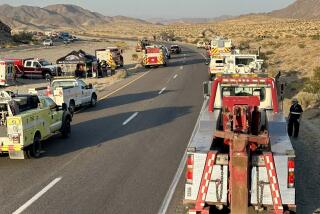Bill That Could Fund Cover for I-15 Extension Advances
- Share via
A bill that could fund a concrete cover over the planned Interstate 15 extension along 40th Street is making headway in Congress, but chances that the project will include more than two blocks of the eight-lane highway remain remote.
The House subcommittee on surface transportation approved a bill Thursday that would free up California’s share of federal highway funds for projects like the 40th Street cover. Mid-City residents have proposed covering the eight-block connection between Adams Avenue and Landis Street to contain noise and pollution and to protect an adjacent elementary school.
Construction of the extension is scheduled to begin in 1990, displacing about 1,300 Mid-City residents.
“This is a critical decision,” said Rep. Jim Bates (D-San Diego). “Without this there was no chance. With it, it’s still a fight.” He said chances are “about 50-50” that the California Department of Transportation, which administers federal highway grants, will approve more cover.
The state has already agreed to cover one block of the extension near the school, and in May, 1985, the San Diego City Council agreed to cover a second block.
The House bill would allow $57 million of the $286 million allotted to California in interstate highway repair funds to be used for environmental protection of primary routes such as 40th Street. The bill, however, does not require funding for such uses and would allow only a portion of the corridor to be covered. The cost of the cover is estimated at $8 million to $12 million per block.
Although the same provision died in the House in 1985, the bill is expected to pass the full Public Works and Transportation committee and the full House this year.
Community activists would like to see all eight blocks covered to contain pollution and provide much needed park space.
“It’s kind of precedent-setting for California,” said Gary Weber, a land use consultant and Normal Heights resident. He said California’s cities lag behind Boston, Tucson and Seattle in making use of covered interstates.
“There wasn’t this discretion option before,” Weber said. “It’s one step closer.” He and others are pushing Caltrans to cover an additional block. “We’re taking it one block at a time,” he said.
Jim Bliesner, founder of the City Heights Community Development Corp., said a stronger statement from the city and new Mayor Maureen O’Connor was needed to convince Caltrans to cover more of the interstate. “All the neighborhoods are united on this, and we’ll continue to have dialogue with Caltrans and the city,” Bliesner said. “If she’s (O’Connor) as receptive as (former Mayor Roger) Hedgecock was, the community will be in good stead.”
But he said he was pessimistic about Caltrans’ response to the bill. “They’re sort of belligerent toward the need to mitigate environmental considerations,” Bliesner said. “All they care about is how quickly a car can get from one place to another, and they’re not in tune with community concerns.”
Bill Dotson, Caltrans district director in San Diego, said highway covers were not traditional Caltrans projects. “I think it would be possible to use a portion of those funds for cut and cover,” he said. “But I think the cut and cover would be the lowest priority because repair, safety, additional capacity and traffic operations are more important to the traveling public.”
More to Read
Sign up for Essential California
The most important California stories and recommendations in your inbox every morning.
You may occasionally receive promotional content from the Los Angeles Times.










